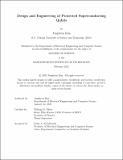Design and Engineering of Protected Superconducting Qubits
Author(s)
Kim, Junghyun
DownloadThesis PDF (10.92Mb)
Advisor
Oliver, William D.
Terms of use
Metadata
Show full item recordAbstract
Building extensible quantum information processors becomes increasingly promising as the qubits exhibit longer coherence times. To this end, realizing protected qubits, whose Hamiltonians are inherently resilient to both relaxation and dephasing, has attracted strong interest. In this thesis, we primarily explore the soft 0 − π qubit, a leading candidate for implementing superconducting qubit protection with current fabrication techniques. To enhance protection, the soft 0 − π qubit requires its two major modes, the charge-mode (θ) and the flux-mode (ϕ), to satisfy an asymmetric condition: maximizing charge-mode capacitance while minimizing flux-mode capacitance. The main challenge is therefore reducing stray capacitance from the large charge-mode capacitor, which hinders the reduction of flux-mode capacitance. To address this challenge, we depart from the conventional coplanar interdigitated capacitor design and use parallel-plate capacitors (PPC) with small footprints, achieving the desired large charge-mode capacitance while reducing unwanted stray capacitances. By reducing the capacitor area by a factor of approximately 50, the PPC 0−π qubit has achieved an estimated Eᵠ_C /Eᶿ_C ratio of 30–50, placing it among the highest reported. Additionally, we propose enhanced mode-selective control of the soft 0−π qubit using these parallel-plate capacitors. Finally, we discuss the remaining challenges of the soft 0−π qubit and introduce alternative parameter regimes that can potentially improve Raman-based control and qubit readout.
Date issued
2025-02Department
Massachusetts Institute of Technology. Department of Electrical Engineering and Computer SciencePublisher
Massachusetts Institute of Technology